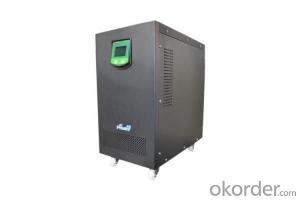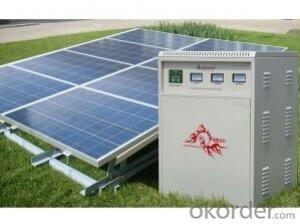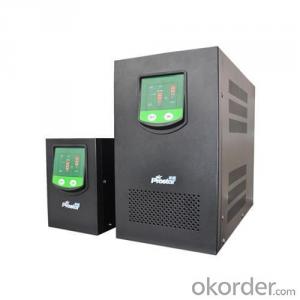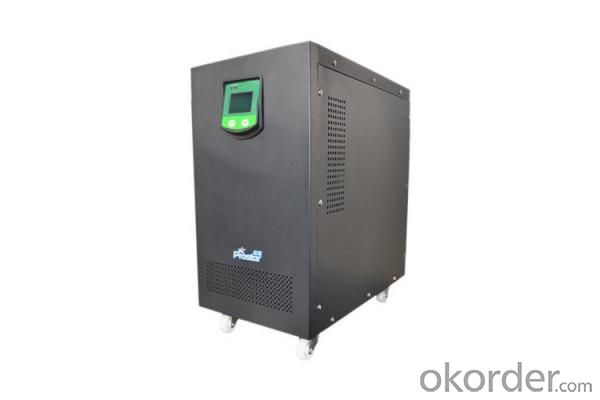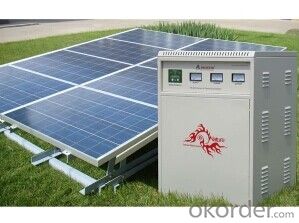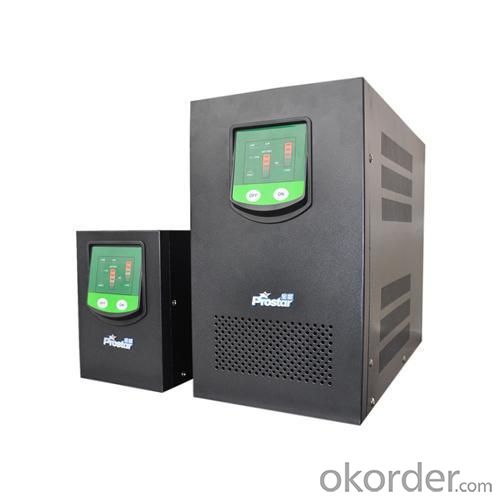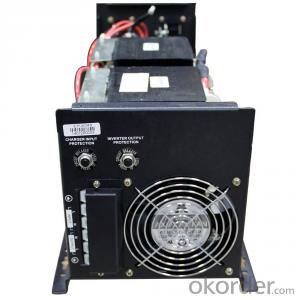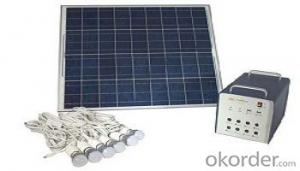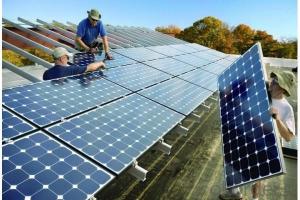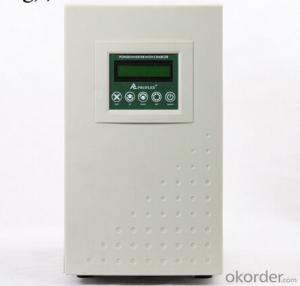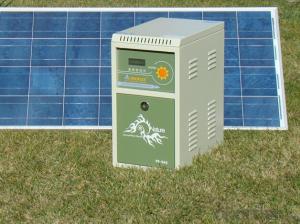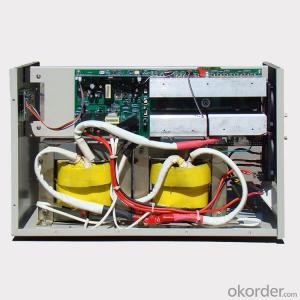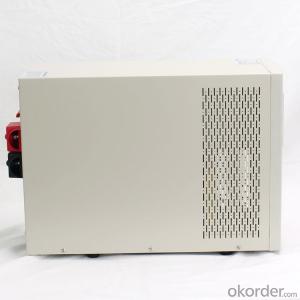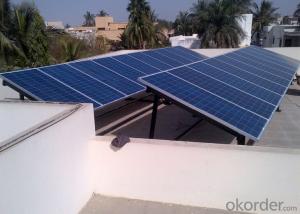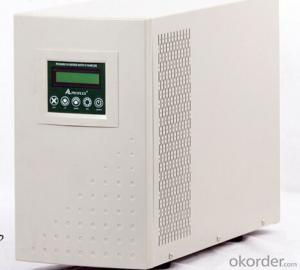Greenhouse Solar Energy Systems:Off Grid Solar Power System PR-SAS2000 with Battery Tank 1600W
- Loading Port:
- Tianjin
- Payment Terms:
- TT OR LC
- Min Order Qty:
- 10 pc
- Supply Capability:
- 10000 pc/month
OKorder Service Pledge
OKorder Financial Service
You Might Also Like
Specification
Specifications
1.Supply 2 work modes: to save electricity bill or to supply long time power backup.
2. Supply battery tank,high integrated.
1- Heat Sink: Aluminum heat sink to dissipate controller heat.
2- LCD: Display the status and data.
3- Battery LED indicator: Three states of battery LED indicator show charging status.
4- Charging LED indicator: Indicate that the battery is charging or not.
5- Fault LED indicator: Indicate that controller faults.
6- Buttons: Browse or modify all parameters.
7- RS-232 port: Monitor controller by PC and update controller software.
8- RS-485 port: Monitor controller by PC and update controller software.
9- RTC battery: Power to RTC, battery model is CR2032.
10- Remote Temperature Sensor port(MC1.5-5.08-2L)
Connection for a RTS (Remote Temperature Sensor, optional) to remotely monitor battery temperature.
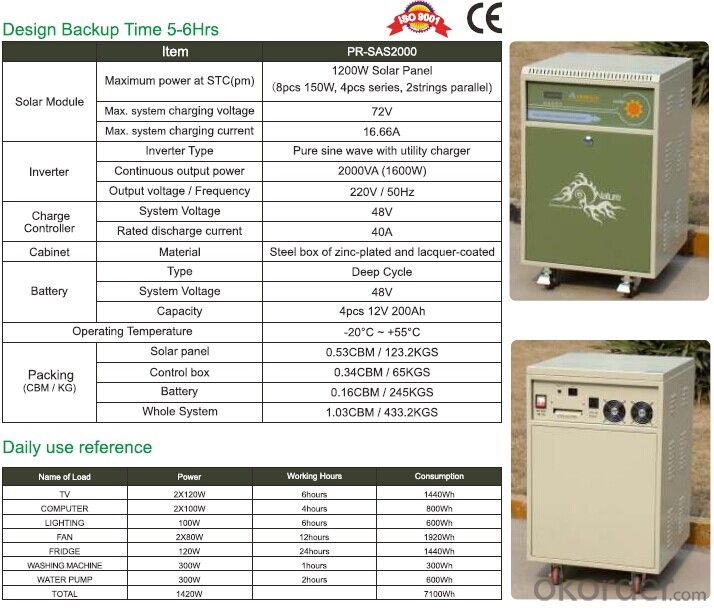
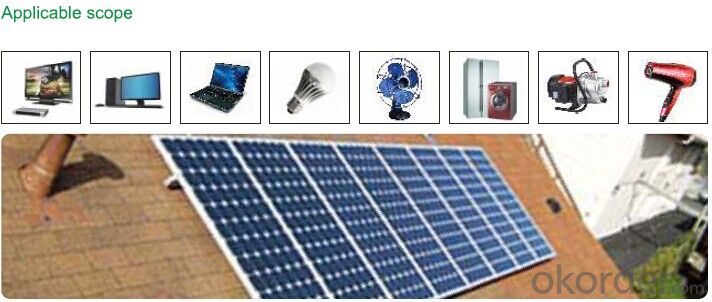
FAQ
1. How do I decide which system is right for me ?
For protection from long outages, include a generator or solar panels in your Must solar system. Shorter outages can be handled by a battery-only system.
2. Where my system will be installed ?
Must solar systems are usually wall-mounted near a home's main electrical (circuit breaker) panel.
3. How do I install my system ?
A solar backup inverter is connected to a home electric system , we will supply detailed installation manual and videos for our customers .
- Q: Do solar energy systems require planning permission?
- Yes, solar energy systems typically require planning permission in most regions. The exact regulations and requirements may vary depending on the location and the specific characteristics of the system. It is advisable to consult with local authorities or a professional installer to ensure compliance with the relevant planning regulations and obtain proper permission before installing a solar energy system.
- Q: Can solar energy systems be used for powering remote cabins or cottages?
- Certainly, solar energy systems have the ability to effectively power cabins or cottages in remote areas. In fact, solar power is an optimal option for locations that are not connected to the utility grid, as it offers a sustainable and dependable source of electricity. Solar energy systems consist of solar panels that convert sunlight into electricity, a charge controller to regulate battery charging, and an inverter to convert stored energy into usable AC power. This setup enables the panels to capture sunlight during the day and store excess energy in batteries for use during the night or on cloudy days. Remote cabins or cottages often lack access to conventional power sources, making solar energy systems an ideal solution. These systems can be custom-designed to meet the specific energy requirements of the cabin, taking into consideration the number of appliances, lights, and other electrical devices used. By appropriately sizing the solar panels and batteries, it is possible to provide sufficient power to meet the occupants' needs. Furthermore, solar energy systems require minimal maintenance and can endure for several decades with proper care. This makes them a cost-effective and dependable power source for remote cabins or cottages, eliminating the need for noisy and polluting diesel generators or the inconvenience of transporting fuel to the remote location. Additionally, solar energy systems can be combined with other renewable energy sources like wind turbines or micro-hydro systems to create hybrid power systems, ensuring a continuous power supply even during periods of limited sunlight. To sum up, solar energy systems are an outstanding choice for powering remote cabins or cottages. They offer a sustainable, reliable, and low-maintenance source of electricity, allowing occupants to enjoy the comforts of modern living even in remote locations.
- Q: Can solar energy systems be used in powering telecommunications towers?
- Solar energy systems have the capability to be utilized in order to supply power to telecommunications towers. Solar energy, which is a renewable power source, utilizes the sun's energy to create electricity. In order for telecommunications towers to function properly, they require a steady and reliable source of electricity, and solar energy can provide a sustainable solution for this requirement. To capture sunlight and convert it into electricity, solar panels can be installed either on the tower itself or in its immediate vicinity. This electricity can then be stored in batteries to be used during periods of limited sunlight or at night. In locations that are distant or not connected to an electrical grid, where gaining access to electricity is difficult or costly, the use of solar energy systems can be especially advantageous for powering telecommunications towers. Furthermore, solar power lessens reliance on fossil fuels, diminishes carbon emissions, and ultimately reduces operating expenses. All in all, solar energy systems present a feasible and environmentally-friendly choice for powering telecommunications towers.
- Q: Can solar energy systems be used in powering disaster relief centers or emergency shelters?
- Solar energy systems can indeed be used to power disaster relief centers or emergency shelters. In fact, these systems are increasingly being utilized in such situations due to their numerous benefits. One of the main advantages of solar energy systems is their ability to operate independently from the grid. When natural disasters or emergencies occur, the conventional power grid may be disrupted or completely unavailable. In such cases, solar panels can generate electricity from sunlight, providing a reliable and sustainable source of power for essential operations in relief centers or shelters. Furthermore, solar energy systems are highly portable and modular, making them ideal for temporary installations. They can be quickly deployed and set up in disaster-stricken areas, offering immediate power for lighting, communication devices, medical equipment, and other critical needs. Additionally, these systems can be easily expanded or adjusted to meet the increasing energy demands of relief centers or shelters as the situation unfolds. Moreover, solar power systems have minimal environmental impact compared to traditional fuel-based generators. They produce clean energy without emitting harmful pollutants or greenhouse gases, which is particularly important in disaster-stricken areas where air quality may already be compromised. Lastly, solar energy systems provide long-term cost savings. Once installed, solar panels require minimal maintenance and have a lifespan of 25-30 years. This reduces the reliance on expensive and often scarce fuel supplies, enabling relief centers and emergency shelters to allocate their resources more efficiently. To conclude, solar energy systems are a reliable, sustainable, and cost-effective solution for powering disaster relief centers or emergency shelters. Their ability to operate independently, portability, minimal environmental impact, and long-term cost savings make them an excellent choice for powering critical operations during times of crisis.
- Q: Can solar energy systems be used for water heating?
- Yes, solar energy systems can be used for water heating. Solar water heating systems use the sun's energy to heat water, which can then be used for various purposes such as bathing, cooking, or space heating. These systems typically consist of solar collectors, which absorb sunlight and convert it into heat, and a storage tank to store the heated water. Solar water heating is a sustainable and cost-effective way to meet the hot water demand in residential, commercial, and industrial settings.
- Q: What are the key components of a solar energy system?
- The key components of a solar energy system are solar panels, an inverter, batteries (optional), and a charge controller.
- Q: Are there any risks of electrical hazards during installation or maintenance of solar energy systems?
- Yes, there are risks of electrical hazards during the installation or maintenance of solar energy systems. Solar energy systems involve working with high-voltage DC (direct current) electricity, which can pose dangers if not handled properly. Some of the potential risks include: 1. Electrocution: Solar panels generate electricity, and if not isolated or disconnected properly, there is a risk of electrocution for individuals working on the system. 2. Fire Hazards: Faulty wiring, loose connections, or improper installation can lead to electrical arcs and sparks, which can ignite a fire if proper precautions are not taken. 3. Falls and Injuries: Solar panels are typically installed on rooftops, which may involve climbing ladders, working at heights, and handling heavy equipment. If not done with caution, it can result in slips, falls, or injuries. 4. Arc Flash: When working on live electrical equipment, there is a risk of arc flash, which is a sudden release of energy that can cause severe burns, hearing damage, and even death. 5. Environmental Risks: While not directly related to electrical hazards, it is essential to consider potential environmental risks during the installation of solar energy systems. For instance, improper disposal of hazardous materials used in solar panels, such as lead, cadmium, or other toxic substances, can harm the environment if not handled correctly. To mitigate these risks, it is crucial to follow proper safety protocols and guidelines during the installation and maintenance of solar energy systems. This includes wearing personal protective equipment (PPE), ensuring proper grounding and isolation procedures, using insulated tools, and following all local electrical codes and regulations. It is also recommended to hire trained and certified professionals for the installation and maintenance to minimize the risks associated with electrical hazards.
- Q: What is a photovoltaic solar energy system?
- A photovoltaic solar energy system is a renewable energy system that converts sunlight into electricity. It utilizes solar panels composed of multiple solar cells, which consist of semiconductors, usually silicon, that absorb photons from sunlight. When sunlight hits the solar panels, the photons transfer their energy to the electrons in the semiconductors, energizing them and generating an electric current. This current, initially in direct current (DC) form, is then converted into alternating current (AC) using an inverter, making it suitable for use in homes, businesses, or the electrical grid. Key components of a photovoltaic solar energy system include the solar panels, usually mounted on rooftops or open areas to maximize sunlight exposure. Various solar panel technologies exist, such as monocrystalline, polycrystalline, or thin-film, each with different efficiency levels and costs. To maximize efficiency, solar panels are often positioned at optimal angles and directions to capture as much sunlight as possible throughout the day. Additionally, inverters are employed to convert the generated DC electricity into AC electricity, which is the standard form used by most electrical appliances and devices. Photovoltaic solar energy systems offer numerous advantages. They contribute to environmental preservation by producing clean and renewable energy, reducing greenhouse gas emissions. They also have the potential to save costs by reducing or eliminating reliance on traditional energy sources. Furthermore, they require minimal maintenance and have a lifespan of around 25 to 30 years. In summary, a photovoltaic solar energy system effectively harnesses the sun's power to produce electricity, offering a sustainable and eco-friendly alternative to conventional energy sources.
- Q: Are there any environmental impacts associated with solar energy systems?
- Solar energy systems do have some environmental impacts, although they are generally considered to be much less harmful than those associated with traditional energy sources. Greenhouse gases and other pollutants can be released during the production and disposal of solar panels, especially if not managed properly. Additionally, the mining and extraction of raw materials used in solar panels, like silicon, can cause negative environmental consequences. However, these impacts are relatively minor when compared to the emissions and pollution caused by fossil fuel-based energy generation. Moreover, solar energy systems do not generate air or water pollution during operation and do not contribute to climate change. Overall, while there are some environmental impacts related to solar energy systems, they are significantly outweighed by the long-term benefits of reducing greenhouse gas emissions and transitioning to clean and renewable energy sources.
- Q: Can solar energy systems be used in agricultural settings?
- Yes, solar energy systems can definitely be used in agricultural settings. In fact, the use of solar energy in agriculture has been gaining popularity in recent years. Solar panels can be installed on rooftops or as ground-mounted systems in agricultural fields to generate clean and renewable electricity. There are several ways in which solar energy can be utilized in agricultural settings. One common application is to power irrigation systems. Solar-powered water pumps can efficiently draw water from wells or other water sources and distribute it for irrigation purposes. This helps farmers reduce their dependence on fossil fuel-powered pumps and lowers their overall energy costs. Solar energy can also be used to power electric fences, lighting systems, and ventilation systems in livestock operations. These systems help improve the conditions for animals, enhance productivity, and reduce the environmental impact of traditional energy sources. Additionally, solar energy can be utilized for crop drying and processing. Solar dryers can be used to remove moisture from crops, reducing the risk of spoilage and improving their shelf life. Solar-powered processing equipment, such as grain mills and oil presses, can also be employed to enhance the efficiency and sustainability of agricultural operations. Moreover, solar energy systems can provide a reliable source of electricity to remote agricultural areas that are not connected to the grid. This enables farmers to access modern technologies and improve their productivity and income. Overall, the integration of solar energy systems in agricultural settings offers numerous benefits. It reduces greenhouse gas emissions, decreases reliance on fossil fuels, lowers energy costs, improves efficiency, and enhances the sustainability of agricultural practices. Therefore, solar energy is a viable and promising option for powering various agricultural activities.
Send your message to us
Greenhouse Solar Energy Systems:Off Grid Solar Power System PR-SAS2000 with Battery Tank 1600W
- Loading Port:
- Tianjin
- Payment Terms:
- TT OR LC
- Min Order Qty:
- 10 pc
- Supply Capability:
- 10000 pc/month
OKorder Service Pledge
OKorder Financial Service
Similar products
Hot products
Hot Searches
Related keywords
